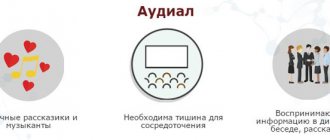Each person perceives the world differently, giving more importance to some feelings and less to others. Based on this criterion, psychologists divide all people into 4 groups: visual, auditory, discrete and kinesthetic. For the first, the main source of information is what is seen, for the second - what is heard, for the third - what is meaningful, and for the fourth, what can be touched is the most informative. Today we will talk in detail about kinesthetics - those who receive the most information and emotions from touch, movements and other sensations.
Who is a kinesthetic learner?
A kinesthetic person is a person who perceives the world around him through body sensations (touch, movement, taste, smell, etc.). A person with this type of perception attaches the greatest importance to physical sensations, remembers them better, makes various associations with them and always remembers first of all what he felt , and not what he saw, heard or thought about.
For example, upon returning from vacation, he will tell you that the food was very tasty, the water in the sea was warm, and the air in the hotel room was cool. At the same time, the landscapes, hospitality of the local population, music, convenience of routes and other features of the resort fade into the background. In life, kinesthetics are most interested in things that give vivid bodily sensations. They are fond of dancing, love sports, prefer to relax in motion, and often choose unusual hobbies such as artistic forging or pottery.
The above does not mean that a kinesthetic person will refuse to go to the cinema with you. Of course, he would prefer to go dancing or to the roller skating rink, but he also loves cinemas, like any other person. At the same time, if you allow him to choose which session to go to, he will prefer something in 3D and always with a maximum emphasis on special effects. In a cinema, it is important for a kinesthetic learner to have a sense of presence, and the sound effects enveloping the body to make the hairs on the skin move.
As a rule, kinesthetics have very well developed coordination of movements and fine motor skills, which usually determines their professional path. In most cases , they prefer work related to movement (choreography, sports career), or choose professions in which they need to do something with their hands (repair of all kinds of equipment, various industries, manual and surgical areas in medicine).
If we talk about learning abilities, then kinesthetics are fine with this. Listening to a lecture or reading a book, they also remember the material quite well, but provided that we are talking about some physical phenomena that can be imagined. If we are talking about logical conclusions or complex theoretical reasoning, which are in no way projected onto sensations, kinesthetic learners quickly begin to get bored and perceive the material much worse.
How does the type of perception influence the learning process?
Knowing the characteristics of your own perceptual system helps organize the learning process.
The process of presenting information for visual learners must be accompanied by clarity. They have good skills in working with text and, if desired, quickly master the technique of speed reading. They remember information well by making mind maps or graphs, working with demonstration models, and gaining knowledge through experimental activities.
Important! Extraneous sounds will not interfere with the concentration of the visual. With the TV on, he will be able to prepare for the exam just as well using diagrams and tables as in silence
The main channel of perception of educational material for an auditory child is hearing. Lectures are comfortable for him. He learns new material well by participating in discussions and conversations.
For kinesthetic learners, the learning process should involve the possibility of movement and practical actions. The most suitable forms of organizing the educational process for him are practical and laboratory work.
Important! These people have unstable attention. However, their advantage is the rapid switching from one activity to another.
Digital students excel in logical disciplines and programming. Computerized learning suits them. The material will be absorbed by the digital if he understands its logical basis, and new information will be superimposed on his existing knowledge and organically fit into his picture of the world.
The main signs of kinesthetics
Even with a very good understanding of who a kinesthetic person is and what behavioral features are characteristic of him, it is quite difficult to identify a person with this type of perception. Often he himself is not aware of his peculiarity, let alone recognizing him by external signs and habits. And yet it is possible, although this will require communicating with the person often and regularly. Let's look at some of the most obvious signs that identify people who have a predominant kinesthetic type of perception:
- Characteristic words. Since bodily sensations are important to a kinesthetic learner, he often talks about these feelings. His phrases constantly contain the words “soft”, “warm”, “rough”, “silky”, “hot”, “felt” - those that convey certain sensations.
- Pay attention to air temperature and other conditions. Kinesthetic people are sensitive to discomfort. They are the first to notice that the room is cold, hot or stuffy. Strong smells can distract them, making it difficult to concentrate. Therefore, they do not like it when someone in the office has a snack at work.
- Gestures and touches in communication. Communication with loved ones, friends and acquaintances is important for any person. This is not just an exchange of information, but also an exchange of emotions. Therefore, kinesthetic learners, when communicating, gesticulate very actively and often unobtrusively touch the interlocutor (which should not be taken at all as flirting). When they see an interesting object, they try to touch it instead of looking at it.
- Orderly arrangement of things. Kinesthetic learners do not like chaos in the workplace or in personal belongings, since it is more difficult for them to visually find the necessary objects. Therefore, he prefers to know where everything is.
- Restrained behavior. In society, such people behave calmly, often looking immersed in thoughts or their own experiences.
- Profession, hobbies and interests. Pay attention to what a person does, what he is interested in and how he relaxes. If he works as a massage therapist, in his free time he sculpts sculptures from alabaster or collects models, and prefers to relax on the dance floor - you are probably a kinesthetic person.
- Comfortable and practical clothes. As noted above, kinesthetic learners value comfort. Therefore, when choosing clothes, they are guided by considerations of convenience and practicality, completely not understanding why style and compliance with fashion trends are so important for others.
Interestingly, kinesthetic learners are often hyperactive in childhood, but with age they usually become much calmer. From the outside they often look like introverts, but this is not entirely true. They are not withdrawn, they just communicate more calmly than other people. It is often important for them that a loved one simply be nearby, since they feel his presence literally on a physical level.
Perception of the essence of a scene according to Castellano and Henderson
Have you ever wondered what the expression “a picture says a thousand words” really means? Or why do we perceive images better than text?
This does not mean that the image tells us all the information we need. A person simply has the ability to grasp the main elements of a scene at one glance. When we fix our gaze on an object or objects, we form a general idea and recognize the meaning of the scene.
What is scene perception? According to Nissan Research & Development researcher Ronald A. Rensink:
“Scene gist, or scene perception, is the visual perception of the environment as an observer at any given time. It includes not only the perception of individual objects, but also such parameters as their relative positions, as well as the idea that other types of objects are encountered."
Imagine that you see certain objects that represent two signs with symbols, and a diagram that symbolizes a fork and indicates two different paths. Most likely, the following scene appeared in front of you - you are in the middle of the jungle/forest/highway and there are two paths ahead that lead to two different destinations. Based on this scene, we know that a decision must be made and one path must be chosen.
In 2008, Monica S. Castelhano of the University of Massachusetts Amherst and John M. Henderson of the University of Edinburgh studied the effect of color on the ability to perceive the essence of a scene.
The experiment included three different trials. Students were shown several hundred photographs (natural or man-made objects) under different conditions for each test. Each image was shown in a specific sequence and time point. Participants were asked to respond “yes” or “no” when they saw details that matched the scene.
Normal and blurred photographs were presented with color and monochrome photographs, respectively.
To determine the role of colors in the perception of the essence of a scene, anomalous colors were used for the following example photographs:
The study authors also examined the range of deviations using the following samples:
How do we perceive visual information based on Castellano and Henderson's findings?
- The subjects grasped the essence of the scene and the target object within seconds. This means that people can quickly understand the meaning of a normal scene.
- The subjects were faster at matching color pictures than black and white ones. Thus, color helps us understand a picture better.
- In general, colors determine the structure of objects. The better a color matches the way we typically perceive the world, the easier it is for us to understand the meaning of the image.
Information Design Tip #5 Based on Castellano and Henderson's Scene Perception Research: Use appropriate icons or pictures to represent data; arrange content in the correct sequence; use familiar colors for important objects.
Psychological portrait of a kinesthetic learner
To better understand who a kinesthetic person is and how best to behave with him, it is advisable to understand the characteristics of his psyche. Psychologists identify several character traits characteristic of people with this type of perception:
- Impulsiveness. Despite the characteristic calmness in communication, the kinesthetic person often begins to act without thinking through the consequences and without drawing up any plan. At the same time, he values stability, so he chooses those paths that seem to him the least risky.
- Non-conflict. Emotions for kinesthetics are comparable to physical feelings, and any conflict that may seem like a harmless showdown to other people causes them pain. Therefore, they try to avoid conflicts, and they do this very skillfully.
- Silence. Kinesthetic people speak little, which is why they seem modest and timid to others. In fact, they are simply not very talkative, and when communicating, communication is more important to them than communication.
- Melancholy. This does not mean that all kinesthetic people are melancholic. They are simply so immersed in their thoughts and feelings that they literally do not notice the events happening around them.
- Conservative. People with this type of perception do not like to rebel against established traditions. They prefer the world around them to be as predictable as possible.
It cannot be said that the listed features make a person better or worse for others. You just need to understand and take them into account, in particular, so as not to be offended that your kinesthetic friend did not notice your new hairstyle or the stylishly folded handkerchief in your pocket. But he is a very peace-loving, flexible and reliable person with whom you can build harmonious friendships or romantic relationships.
Complex forms of information perception
Forms of information perception are understood to be certain categories that are based on reflection and a focus on searching for truth.
Perception of space. Each of us has a very individual approach to the perception of space. If we are transferred to another place, we will not be able to immediately find our way until we develop behavioral tactics and understand how best to behave. One person is able to navigate changing conditions differently than another and everyone has their own perception.
Perception of time. Each of us has our own biological clock that reminds us to take certain actions. There is a common theory about night owls and early risers. Some find it difficult to wake up in the morning; they may stay awake during the day; others need to get up early and go to bed early. If you ask a person on the street with the question “What time is it?”, most will immediately start looking for a watch to answer you. Meanwhile, inside everyone knows approximately what time it is at the moment. This is why the process of planning any business, predicting various situations even before they happen in reality, becomes possible.
Perception of movement. Impressions of movement are created purely individually. It is enough for someone to tilt their head forward and take the appropriate position of their body to create the illusion that they are moving in space. The perception of movement is recorded by the brain and realized by the individual through the vestibular apparatus and one’s own thoughts and subjective moods.
Perception is intentional and unintentional. These forms differ from each other in the participation of consciousness in the perception of any objects. Otherwise, they can also be called involuntary and voluntary
In the first case, perception is carried out due to external circumstances that attracted a person’s attention, and in the second, it is guided by consciousness. Intentional perception is characterized by a clear goal, defined tasks, a clear structure and consistency in the implementation of all necessary steps.
Kinesthetic woman
Women with a kinesthetic type of perception love to attend various relaxing procedures. They like massages and jacuzzi, they like to spend time in hairdressers or nail salons, and they do not do it for the sake of beauty. just like the tactile sensations associated with these procedures. Therefore, they always have well-groomed skin, nails and hair.
Usually such ladies have good relationships on the personal front, since they are always very affectionate and gentle with their partner. They never forget to hug and kiss him, willingly give him a massage, and pay great attention to caressing his body. Another advantage in relationships with women who have kinesthetic perception is that they do not disperse their attention to the men around them . They wear simple and comfortable clothes and avoid fashionable outfits and bright makeup.
Male kinesthetic
Men with a kinesthetic type of perception attach little importance to appearance, both their own and that of others. And yet, when choosing a companion, they pay attention to the shape of her body, skin and hair, since touch is very important to them. At the same time, they prefer ladies who do not overuse cosmetics and perfume, but who are neat and well-groomed.
Such men don’t care much about their own appearance, not trying to look bright and stylish. They prefer simple and comfortable haircuts, most often either clean-shaven or growing a neat beard that does not require complex care and does not cause inconvenience. They prefer clothes that are comfortable and practical, because they are not ready to sacrifice their own comfort for the sake of a stylish look. Kinesthetic men are quite talkative and like to talk about feelings.
How to deal with a kinesthetic learner?
It should always be taken into account that a kinesthetic person is a very calm, tactful and peace-loving, but at the same time touchy person. At the same time, he is not inclined to talk about his grievances out loud, so you will not even know how you offended him. To make the kinesthetic person feel comfortable with you, remember that he attaches special importance to such details as:
- Comfort. Always remember that bodily comfort is more important to him than to you. Therefore, pay attention to the environment in which you spend time together. If you want him to appreciate you and enjoy spending time with you in the future, make sure that he doesn’t feel hot, stuffy or cold around you.
- Touching. Of course, touching should be appropriate to your relationship and not be intrusive. If this is your girlfriend or boyfriend, you need to pay more attention to touching, but it is better not to do this in crowded places. If your relationship is more friendly or friendly, then start paying attention to such moments as the correct handshake - many people today treat this gesture carelessly, completely forgetting its meaning.
- Personal items. Kinesthetic learners don’t like it when someone touches their things, but it’s even worse when someone moves them around. Keep in mind that this can greatly offend them.
- Tasty food. The way to the heart of a kinesthetic learner truly lies through the stomach. He pays less attention to the beautiful presentation of dishes, but subtle notes of taste and texture features are very important to him.
- Comfortable clothes. Such people like comfortable clothes, and they also love active recreation. They are always ready for it, and choose clothes accordingly. And if you’re going to the cinema with a kinesthetic student, he won’t be at all upset if along the way you decide that it’s better to go rollerblading. Therefore, when going to a meeting with him, you should dress more practically.










